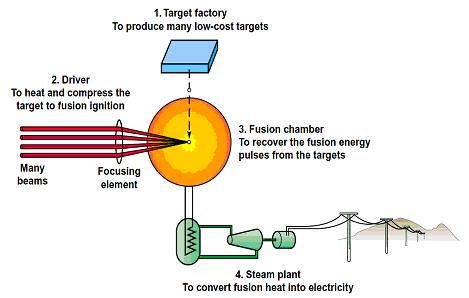Ø Inertia Confinement
ii) Inertia Fusion Power Plant
A fusion power plant is expected to be similar to a conventional one, but with heat energy coming from a fusion reactor. In an IFE power plant, many (typically 5-10) pulses of fusion energy per second would heat a low-activation coolant, such as lithium-bearing liquid metals or molten salts, surrounding the fusion targets. The coolant in turn would transfer the fusion heat to a power conversion system to produce electricity as in a conventional power plant.

Source: https://lasers.llnl.gov/programs/ife/how_ife_works.php
An inertia fusion reactor would have three major facilities:
· A target fabrication plant, target injection and tracking systems - The target factory must produce a continuous supply of high-quality targets at an acceptable cost. Typically, the deuterium-tritium (D-T) fusion fuel is contained in a spherical fuel capsule made of suitable materials such as beryllium, carbon or carbon-hydrogen polymers. The fuel capsule must be cold enough for D-T to freeze and form a layer of D-T ice on the inner wall of the capsule. The target injection and tracking systems injects the targets to the ideal fixed position with beams well aligned to assure the precise illumination required to achieve ignition and high energy gain. For an inertia fusion reactor, the targets will have to be injected at speeds greater than 100 meters a second.
· Driver – Drivers are likely to be high power lasers operating at a repetition rate of five to ten shots a second.
· A target chamber and heat recovery plant - Each fusion target releases a burst of fusion energy in the form of high-energy (14-million-electron-volt) neutrons (about 70 percent of the energy), X-rays and energetic ions. The fusion chamber must contain this blast of energy and convert the sequences of energy pulses into a steady flow of power for the power conversion system. The chamber design must include a 50- to 100-centimeter-thick region that contains lithium (as a liquid metal, molten salt or solid compound) in order to produce tritium through nuclear reactions with the fusion neutrons. This region is called the breeding blanket and must produce at least one tritium atom for every tritium atom burned in the fusion target – a tritium breeding ratio equal to or greater than one.